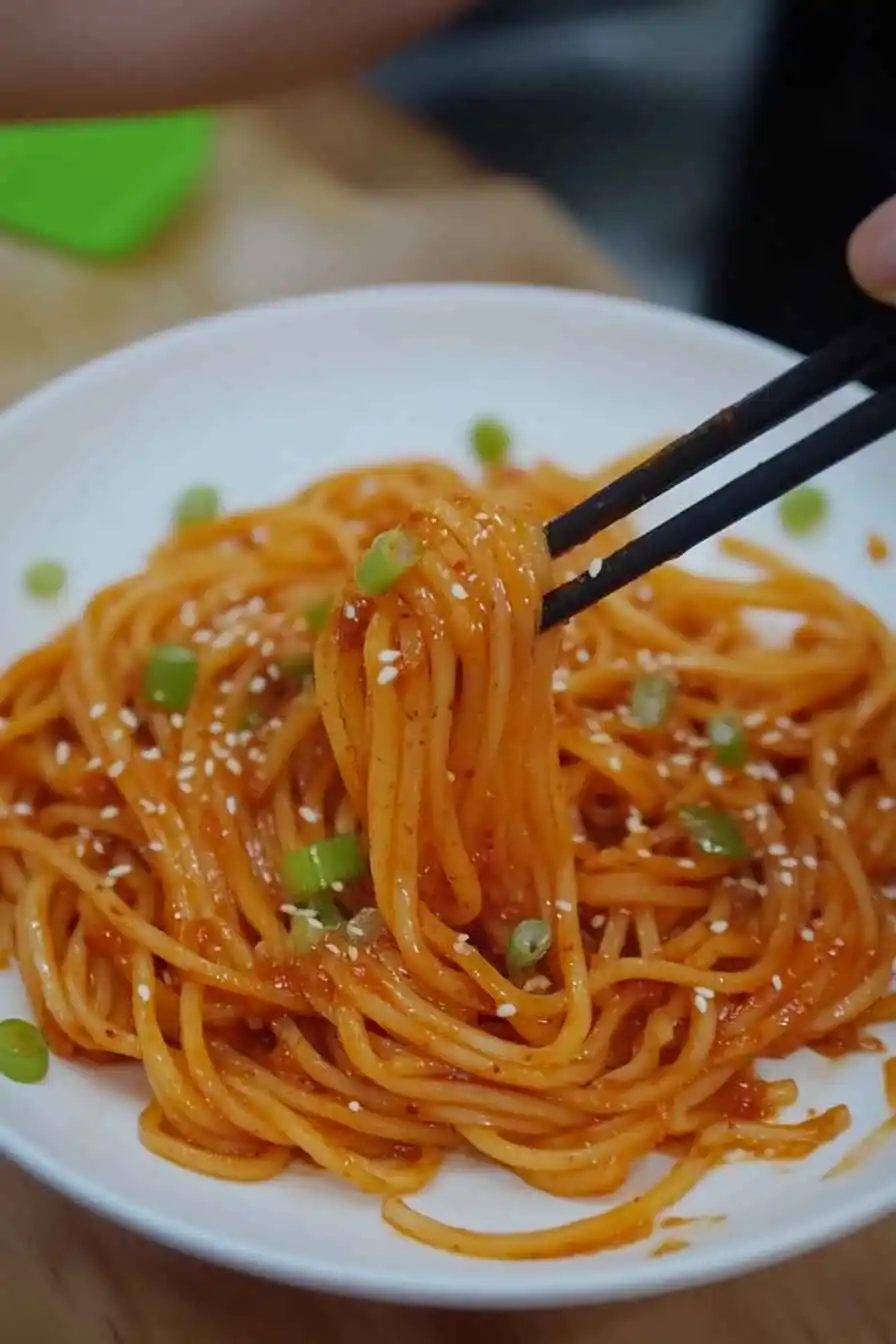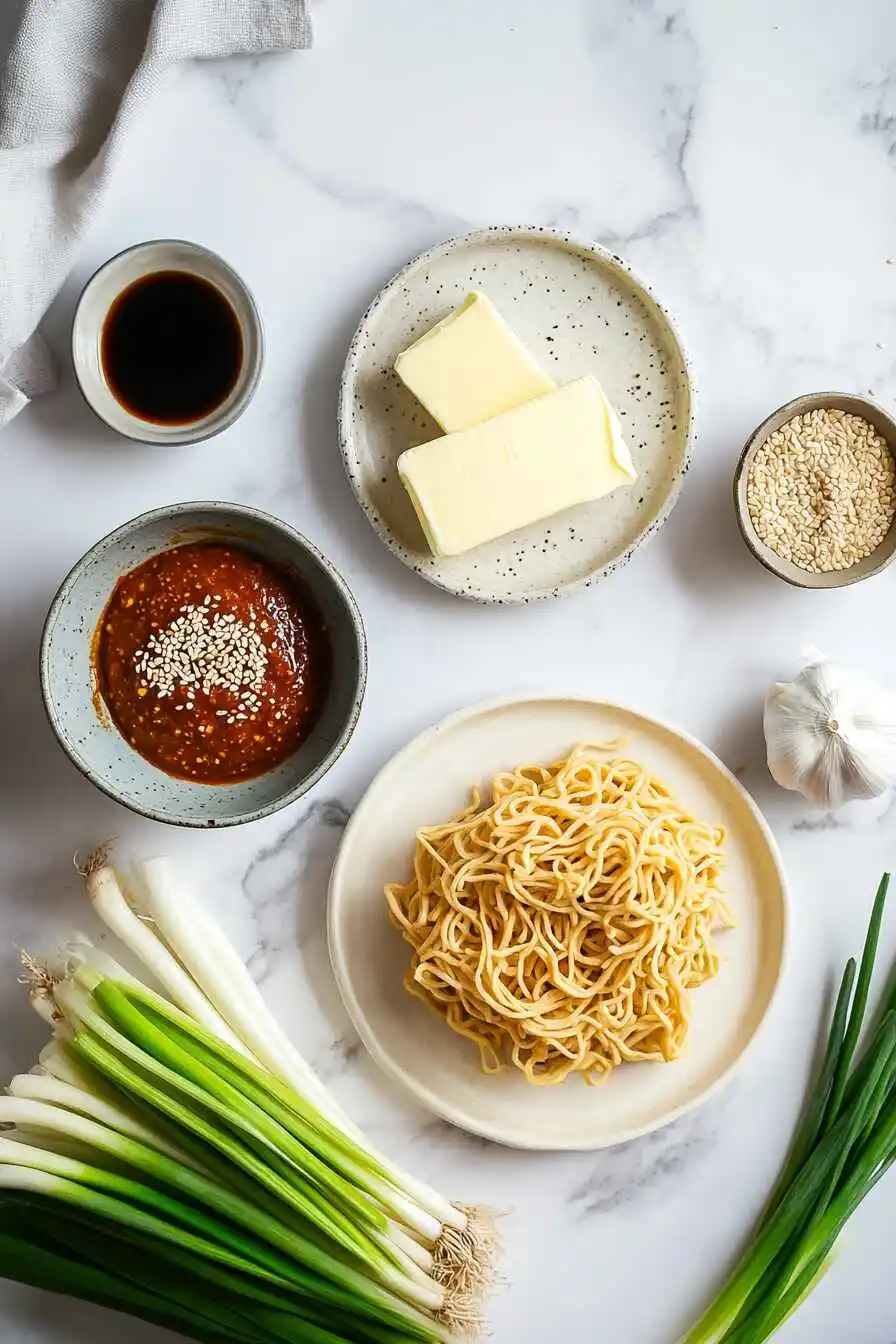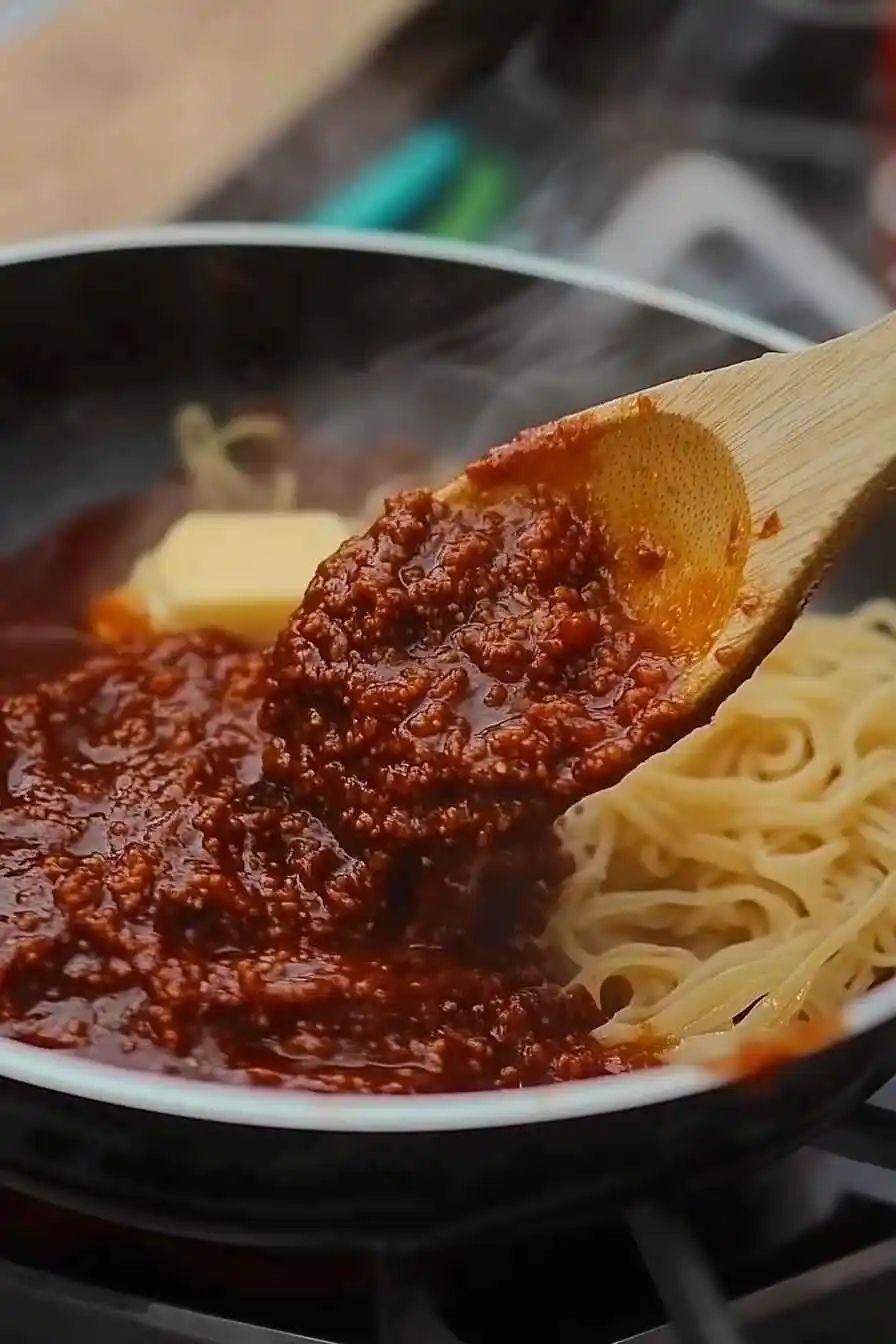
Table of Contents
Why You’ll Love Gochujang Buttered Noodles
Craving a quick, flavorful meal that combines spice, creaminess, and umami in one bite? Gochujang buttered noodles are the perfect dish for busy weeknights or whenever you need comfort food with a kick. This dish balances the rich, smooth taste of butter with the bold, slightly sweet heat of gochujang, a traditional Korean chili paste.
But why has this dish become so popular? The answer is simple:
“Gochujang buttered noodles bring together the best of both worlds—spicy and creamy—creating an irresistible fusion that’s both satisfying and easy to make.”
A Perfect Balance of Spice and Creaminess
One of the biggest challenges in making a noodle dish is getting the right balance of flavors. Many spicy dishes can feel too overpowering, while creamy ones can sometimes be too heavy. Gochujang buttered noodles solve this problem by blending the deep, fermented flavors of gochujang with the silkiness of butter. The result? A sauce that’s both bold and velvety, coating each noodle perfectly.
If you’ve ever found spicy noodles too harsh, this dish might change your mind. The butter smooths out the heat, making it enjoyable without being overwhelming.
Quick and Easy to Make
Who doesn’t love a meal that comes together in under 15 minutes? Unlike complex recipes that require multiple steps and hours in the kitchen, this dish is simple. All you need are a few pantry staples, a pot of boiling water, and a few minutes to prepare the sauce.
Even if you’re a beginner in the kitchen, you’ll find gochujang buttered noodles easy to make. Plus, you can customize the heat level to your liking by adjusting the amount of gochujang.
Versatile and Customizable
Another reason to love this dish? It’s highly adaptable. Whether you’re adding proteins like chicken, shrimp, or tofu, or tossing in vegetables like spinach, mushrooms, or bell peppers, there’s no wrong way to enjoy these noodles. You can also experiment with different noodle types, from ramen to udon, to match your preference.
If you’re looking for a meal that you can switch up depending on what you have in your fridge, gochujang buttered noodles are the answer.
What Are Gochujang Buttered Noodles?
Before we dive into the recipe, let’s explore what makes this dish unique.
The Origin of Gochujang
Gochujang is a fermented Korean chili paste made from red chili powder, glutinous rice, fermented soybeans, and salt. It has a deep, complex flavor that combines spice, sweetness, and umami—a key reason why it works so well in so many dishes.
Korean cuisine often uses gochujang as a base for marinades, stews, and sauces. It has been a staple ingredient for hundreds of years, providing a rich depth of flavor to many traditional dishes.
Unlike plain hot sauces, gochujang offers a thicker, richer texture that blends perfectly with butter, making it ideal for creamy, spicy noodle dishes.
Why Gochujang Works So Well with Butter
Butter and gochujang might seem like an unusual combination at first, but the two ingredients work beautifully together. Here’s why:
- Butter adds richness: The fat in butter smooths out the heat from gochujang, creating a silky sauce.
- Gochujang provides depth: Its fermented, umami-packed taste enhances the flavor of the noodles.
- The combination creates balance: Spicy foods can sometimes feel too sharp, but butter rounds out the intensity, making the dish more enjoyable.
Think of it as a fusion between Korean spice and Western-style creaminess, resulting in a dish that feels both familiar and exciting.
Key Ingredients for the Perfect Dish

To make gochujang buttered noodles, you only need a handful of ingredients, but choosing the right ones makes all the difference.
Ingredient Checklist
| Check | Ingredient | Quantity |
|---|---|---|
| Noodles (ramen, udon, or spaghetti) | 200g | |
| Gochujang | 2 tbsp | |
| Butter | 2 tbsp | |
| Garlic (minced) | 2 cloves | |
| Soy sauce | 1 tbsp | |
| Honey or sugar | 1 tsp | |
| Sesame seeds | 1 tsp | |
| Green onions (chopped) | 2 stalks |
Step-by-Step Guide to Making Gochujang Buttered Noodles
Now that we have all the ingredients ready, let’s walk through the exact steps to make the perfect bowl of gochujang buttered noodles. This dish is incredibly simple, but following the right technique ensures a rich, flavorful result.
Prepping the Ingredients
Before you start cooking, take a few minutes to prep everything. Having all your ingredients ready makes the cooking process smooth and stress-free.
- Chop the aromatics – Mince 2 cloves of garlic and chop 2 stalks of green onions. These will add depth and freshness to the dish.
- Measure the seasonings – In a small bowl, mix 2 tablespoons of gochujang, 1 tablespoon of soy sauce, and 1 teaspoon of honey or sugar. This creates the spicy-sweet base of the sauce.
- Prepare the butter – Cut 2 tablespoons of butter into smaller pieces so they melt evenly.
Taking these few minutes to prep makes everything easier once you start cooking.
Cooking the Noodles to Perfection
The type of noodles you use can change the texture and overall experience of the dish. Whether you choose ramen, udon, spaghetti, or rice noodles, the key is to cook them just right.
- Bring a pot of water to a rolling boil – Add a generous pinch of salt to the water.
- Cook the noodles according to the package instructions – Most noodles take 3 to 5 minutes to cook.
- Check for doneness – The noodles should be firm but not hard (al dente). Overcooking will make them mushy, while undercooking will leave them too chewy.
- Reserve some pasta water – Before draining, scoop out ¼ cup of the starchy cooking water. This helps loosen the sauce later.
- Drain and rinse (optional) – If using wheat-based noodles, skip rinsing to keep the starch for better sauce absorption. If using rice noodles, rinse with warm water to prevent sticking.
Making the Gochujang Butter Sauce

The sauce is the heart of gochujang buttered noodles. It should be rich, spicy, and well-balanced.
- Melt the butter – In a pan over medium heat, add 2 tablespoons of butter and let it melt gently.
- Sauté the garlic – Add the minced garlic and stir for about 30 seconds until fragrant. Be careful not to burn it.
- Stir in the gochujang mixture – Add the pre-mixed gochujang, soy sauce, and honey. Stir everything together until smooth.
- Thin the sauce if needed – If the sauce looks too thick, add 1-2 tablespoons of reserved pasta water to loosen it up.
At this point, the sauce should be silky, spicy, and slightly glossy, ready to coat the noodles perfectly.
Combining Everything for the Best Flavor
Once the sauce is ready, it’s time to bring everything together.
- Add the cooked noodles directly into the pan.
- Toss well to coat each strand evenly. The sauce should cling to the noodles, creating a glossy finish.
- Adjust the seasoning – Taste and add a pinch of salt or a few drops of soy sauce if needed.
- Cook for another minute to let the flavors meld together.
Final Touches: Toppings and Garnishes
To make your gochujang buttered noodles even more delicious, finish with a few toppings:
✔ Sprinkle sesame seeds for a nutty crunch.
✔ Garnish with chopped green onions for freshness.
✔ Drizzle sesame oil for an extra layer of richness.
For extra heat, you can add a pinch of red pepper flakes. If you want a cheesy twist, sprinkle grated parmesan or mozzarella on top—it melts beautifully into the spicy sauce.
Common Mistakes to Avoid
While this recipe is simple, a few mistakes can affect the final result. Here’s how to avoid them:
Using Too Much or Too Little Gochujang
Gochujang is concentrated, meaning a little goes a long way. Using too much can make the dish overly spicy, while too little will make it lack depth. Start with 2 tablespoons, then adjust based on your taste.
Overcooking or Undercooking Noodles
Noodles cook quickly, and even 30 seconds too long can make them too soft. Set a timer and test them 1 minute before the suggested cooking time to ensure they have the right texture.
Not Balancing the Butter and Spice
The richness of butter should complement, not overpower, the spice from gochujang. Using unsalted butter gives better control over the saltiness of the dish.
Skipping Important Flavor Enhancers
Garlic, soy sauce, and sesame oil enhance the umami flavor. Skipping them can make the dish taste flat. Don’t leave them out!
Best Variations of Gochujang Buttered Noodles
Want to make your gochujang buttered noodles even more exciting? Try these variations:
Adding Protein: Chicken, Shrimp, or Tofu
✔ Chicken – Sauté thinly sliced chicken breast in a bit of butter before adding the sauce.
✔ Shrimp – Cook shrimp for 2-3 minutes until pink and mix with the noodles.
✔ Tofu – For a vegetarian option, pan-fry cubed tofu until golden brown and toss it in.
Making It Vegan: Dairy-Free Butter Alternatives
If you prefer a plant-based version, swap butter for:
✔ Coconut oil – Adds a mild sweetness.
✔ Olive oil – Keeps it light and savory.
✔ Vegan butter – Offers the closest texture to regular butter.
Spicing It Up: Extra Heat with Chili Flakes
If you love extra heat, try adding:
✔ Korean chili flakes (Gochugaru) – For an authentic Korean kick.
✔ Sriracha or chili oil – Adds more depth and complexity.
✔ Fresh chili slices – Perfect for those who love a spicy bite.
Fusion Ideas: Gochujang Buttered Ramen or Udon
✔ Gochujang Buttered Ramen – Use instant ramen noodles for a quick and easy meal.
✔ Gochujang Buttered Udon – Thick chewy udon absorbs the sauce beautifully.
If you love bold and flavorful Asian-style noodles, you might also enjoy these Mongolian ground beef noodles, which combine savory and slightly sweet flavors in a satisfying dish.
Perfect Side Dishes for Gochujang Buttered Noodles
A bowl of gochujang buttered noodles is satisfying on its own, but pairing it with the right side dishes can take your meal to the next level. Whether you want something light and refreshing or protein-packed, these options will enhance the flavors while keeping the dish balanced.
Light and Refreshing: Korean Cucumber Salad
A spicy, creamy dish like gochujang buttered noodles pairs well with something cool and crisp. Korean cucumber salad (Oi Muchim) is a perfect match.
✔ Crunchy and refreshing – The crisp texture of cucumbers contrasts beautifully with the creamy buttered noodles.
✔ Sweet and tangy – The light seasoning of soy sauce, vinegar, and sesame oil balances out the spice.
✔ Quick to make – Takes just 5 minutes to prepare.
How to Make It:
- Thinly slice 1 cucumber and place it in a bowl.
- Add ½ teaspoon of salt and let it sit for 5 minutes to remove excess water.
- Rinse and drain, then mix with 1 teaspoon soy sauce, 1 teaspoon sesame oil, ½ teaspoon sugar, and ½ teaspoon red pepper flakes (optional).
- Sprinkle with sesame seeds before serving.
This simple side dish cools down your palate, making every bite of gochujang buttered noodles even more enjoyable.
Protein-Packed: Korean BBQ-Style Chicken or Grilled Tofu
For a heartier meal, adding a protein option alongside gochujang buttered noodles makes it more filling and satisfying.
✔ Korean BBQ Chicken – Marinate chicken thighs in soy sauce, sesame oil, garlic, and a little gochujang. Grill or pan-fry for juicy, flavorful bites.
✔ Grilled Tofu – For a vegetarian option, pan-fry or grill tofu slices with the same marinade to add extra flavor.
Both options complement the noodles without overpowering them, making for a well-balanced meal.
Classic Pairing: Kimchi for Extra Flavor
Nothing pairs better with gochujang buttered noodles than a side of kimchi.
✔ Fermented and tangy – Cuts through the richness of butter.
✔ Adds crunch – Provides a satisfying texture contrast.
✔ Boosts gut health – Kimchi is packed with probiotics, making your meal both tasty and nutritious.
If you love bold flavors, don’t skip this classic Korean side!
Storage and Reheating Tips
If you have leftovers (or want to meal prep), here’s how to store and reheat your gochujang buttered noodles while keeping them fresh.
How to Store Leftovers Properly
✔ Refrigerate – Store noodles in an airtight container for up to 3 days.
✔ Separate sauce if possible – If making ahead, keep the sauce separate and mix before serving for the best texture.
✔ Avoid overpacking – Pressing noodles into a container can make them clump together. Instead, lightly toss them with a bit of sesame oil before storing.
Best Ways to Reheat Without Drying Out
✔ Stovetop (Best Option) – Add 1-2 tablespoons of water and reheat over medium-low heat, stirring frequently. This keeps the sauce smooth and prevents the noodles from sticking.
✔ Microwave (Quickest Option) – Place noodles in a microwave-safe bowl, add a splash of water, and cover. Heat in 30-second intervals, stirring in between.
✔ Steamer (For Extra Moisture) – If you have a food steamer, place the noodles inside for 2-3 minutes to restore their soft, fresh texture.
Can You Freeze Gochujang Buttered Noodles?
✔ Not Recommended for Long-Term Freezing – The sauce may separate when reheated.
✔ Freeze Without Sauce – If needed, freeze only the plain cooked noodles, then mix with fresh sauce when ready to eat.
By following these storage and reheating tips, you can enjoy your gochujang buttered noodles anytime without losing flavor or texture.
Frequently Asked Questions
Before we wrap up, here are answers to some common questions about making gochujang buttered noodles.
Can I Make Gochujang Buttered Noodles Less Spicy?
Yes! If you prefer a milder dish:
✔ Use less gochujang – Start with 1 tablespoon instead of 2 and adjust as needed.
✔ Add more butter or cream – This tones down the spice level while keeping the dish flavorful.
✔ Balance with sweetness – Adding extra honey or sugar helps reduce heat.
What Type of Noodles Work Best?
✔ Ramen noodles – Soft and quick-cooking, these soak up sauce well.
✔ Udon noodles – Thick and chewy, great for holding onto rich flavors.
✔ Spaghetti or linguine – A good alternative if you don’t have Asian-style noodles.
✔ Rice noodles – Lighter and gluten-free, perfect for a fresh twist.
Is Gochujang Gluten-Free?
Traditional gochujang contains fermented wheat or barley, so it’s not naturally gluten-free. However, gluten-free gochujang options are available—just check the label!
Can I Use Margarine Instead of Butter?
Yes, but the flavor and texture will change. Margarine has more water content, so it won’t be as rich. If you need a non-dairy alternative, try vegan butter or olive oil instead.
Conclusion
Why You Should Try This Recipe Today
Gochujang buttered noodles are the perfect mix of creamy, spicy, and savory flavors in a single dish. Whether you’re looking for a quick weeknight meal or something exciting to spice up your dinner routine, this recipe delivers.
✔ Ready in under 15 minutes – Perfect for busy days.
✔ Customizable – Add protein, veggies, or adjust spice levels.
✔ Incredibly satisfying – The combination of gochujang and butter makes it hard to resist!
Final Tips for the Best Flavor
- Use quality ingredients – A good gochujang makes a huge difference.
- Don’t skip the butter – It creates the perfect creamy texture.
- Balance the spice – Adjust to your taste with honey or extra soy sauce.
“Once you try these gochujang buttered noodles, they’ll become your go-to comfort meal!”
Now it’s time to grab your ingredients and start cooking. Whether you follow the classic recipe or add your own twist, you’re in for a bowl full of bold, irresistible flavors.

